中国传统文化-功夫-英文讲稿
- 格式:ppt
- 大小:4.45 MB
- 文档页数:33
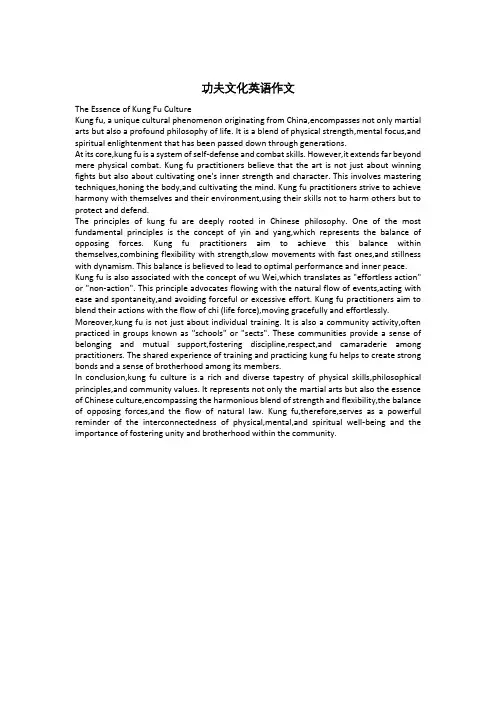
功夫文化英语作文The Essence of Kung Fu CultureKung fu, a unique cultural phenomenon originating from China,encompasses not only martial arts but also a profound philosophy of life. It is a blend of physical strength,mental focus,and spiritual enlightenment that has been passed down through generations.At its core,kung fu is a system of self-defense and combat skills. However,it extends far beyond mere physical combat. Kung fu practitioners believe that the art is not just about winning fights but also about cultivating one's inner strength and character. This involves mastering techniques,honing the body,and cultivating the mind. Kung fu practitioners strive to achieve harmony with themselves and their environment,using their skills not to harm others but to protect and defend.The principles of kung fu are deeply rooted in Chinese philosophy. One of the most fundamental principles is the concept of yin and yang,which represents the balance of opposing forces. Kung fu practitioners aim to achieve this balance within themselves,combining flexibility with strength,slow movements with fast ones,and stillness with dynamism. This balance is believed to lead to optimal performance and inner peace. Kung fu is also associated with the concept of wu Wei,which translates as "effortless action" or "non-action". This principle advocates flowing with the natural flow of events,acting with ease and spontaneity,and avoiding forceful or excessive effort. Kung fu practitioners aim to blend their actions with the flow of chi (life force),moving gracefully and effortlessly. Moreover,kung fu is not just about individual training. It is also a community activity,often practiced in groups known as "schools" or "sects". These communities provide a sense of belonging and mutual support,fostering discipline,respect,and camaraderie among practitioners. The shared experience of training and practicing kung fu helps to create strong bonds and a sense of brotherhood among its members.In conclusion,kung fu culture is a rich and diverse tapestry of physical skills,philosophical principles,and community values. It represents not only the martial arts but also the essence of Chinese culture,encompassing the harmonious blend of strength and flexibility,the balance of opposing forces,and the flow of natural law. Kung fu,therefore,serves as a powerful reminder of the interconnectedness of physical,mental,and spiritual well-being and the importance of fostering unity and brotherhood within the community.。
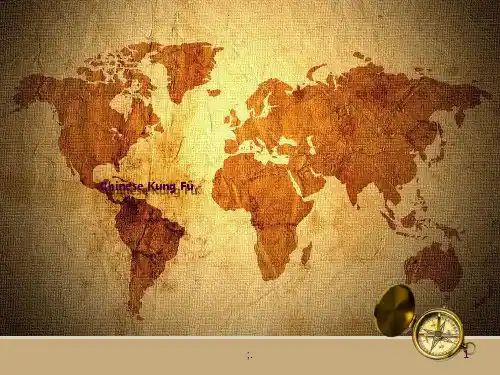
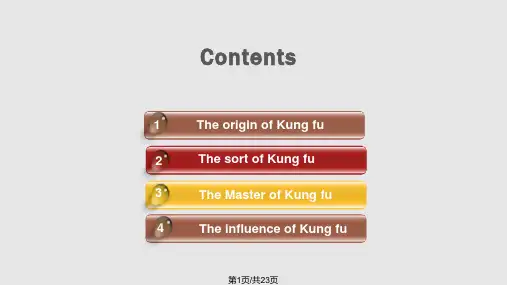
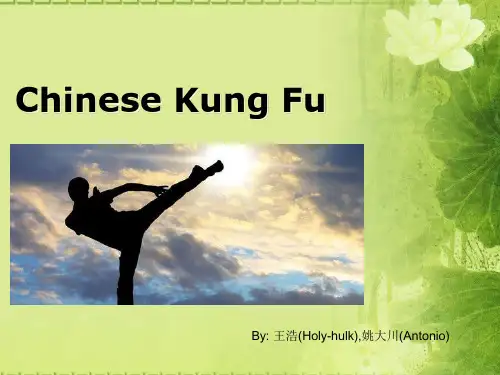
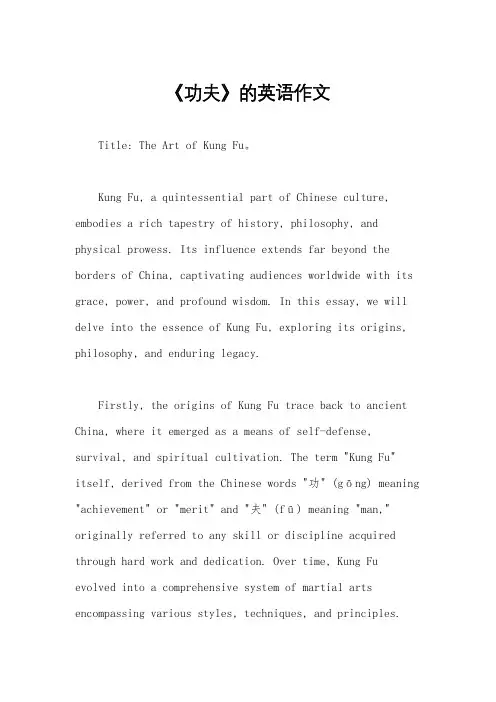
《功夫》的英语作文Title: The Art of Kung Fu。
Kung Fu, a quintessential part of Chinese culture, embodies a rich tapestry of history, philosophy, and physical prowess. Its influence extends far beyond the borders of China, captivating audiences worldwide with its grace, power, and profound wisdom. In this essay, we will delve into the essence of Kung Fu, exploring its origins, philosophy, and enduring legacy.Firstly, the origins of Kung Fu trace back to ancient China, where it emerged as a means of self-defense, survival, and spiritual cultivation. The term "Kung Fu" itself, derived from the Chinese words "功" (gōng) meaning "achievement" or "merit" and "夫" (fū) meaning "man," originally referred to any skill or discipline acquired through hard work and dedication. Over time, Kung Fu evolved into a comprehensive system of martial arts encompassing various styles, techniques, and principles.One of the distinguishing features of Kung Fu is its deep-rooted philosophy, which emphasizes harmony, balance, and self-improvement. Central to this philosophy is the concept of "Wu Wei," or "effortless action," advocating a state of being where one acts spontaneously and in alignment with the natural flow of events. This principle underscores the importance of cultivating inner strength, discipline, and mindfulness in both martial practice and everyday life.Moreover, Kung Fu is not merely about physical combat but also encompasses mental discipline, spiritual cultivation, and ethical values. Practitioners of Kung Fu are encouraged to cultivate virtues such as humility, respect, and integrity, reflecting the traditional Chinese ideals of the gentleman warrior, or "Junzi." This holistic approach to martial arts fosters not only physical prowess but also moral character and mental resilience.Furthermore, Kung Fu is renowned for its diverse array of styles, each with its unique techniques, forms, andphilosophies. From the flowing movements of Tai Chi to the explosive strikes of Shaolin Kung Fu, each style offers its practitioners a path to self-discovery, self-mastery, and self-transcendence. Through diligent practice and unwavering dedication, practitioners of Kung Fu strive to unlock the full potential of their body, mind, and spirit.In addition to its profound philosophical underpinnings, Kung Fu has also left an indelible mark on popular culture, inspiring countless books, films, and television series. From the iconic exploits of legendary masters like BruceLee and Jackie Chan to the timeless wisdom imparted in classic films such as "Enter the Dragon" and "Crouching Tiger, Hidden Dragon," Kung Fu continues to captivate and enthrall audiences around the globe.In conclusion, Kung Fu stands as a testament to the enduring power of human potential, resilience, and determination. Beyond its physical techniques and martial prowess, Kung Fu embodies a timeless philosophy of harmony, balance, and self-cultivation that resonates with people of all backgrounds and cultures. As we continue to explore andembrace the wisdom of this ancient art form, may we find inspiration, enlightenment, and inner peace on our own personal journey of self-discovery and transformation.。

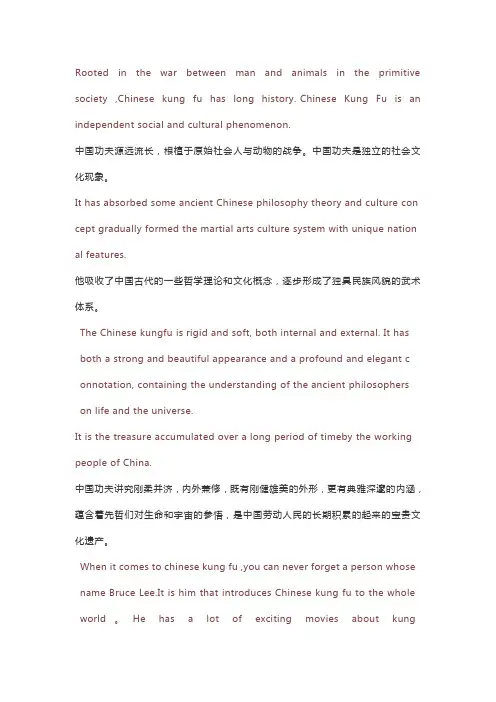
Rooted in the war between man and animals in the primitive society ,Chinese kung fu has long history.Chinese Kung Fu is an independent social and cultural phenomenon.中国功夫源远流长,根植于原始社会人与动物的战争。
中国功夫是独立的社会文化现象。
It has absorbed some ancient Chinese philosophy theory and culture con cept gradually formed the martial arts culture system with unique nation al features.他吸收了中国古代的一些哲学理论和文化概念,逐步形成了独具民族风貌的武术体系。
The Chinese kungfu is rigid and soft, both internal and external. It has both a strong and beautiful appearance and a profound and elegant c onnotation, containing the understanding of the ancient philosophers on life and the universe.It is the treasure accumulated over a long period of timeby the working people of China.中国功夫讲究刚柔并济,内外兼修,既有刚健雄美的外形,更有典雅深邃的内涵,蕴含着先哲们对生命和宇宙的参悟,是中国劳动人民的长期积累的起来的宝贵文化遗产。
When it comes to chinese kung fu ,you can never forget a person whose name Bruce Lee.It is him that introduces Chinese kung fu to the whole world。
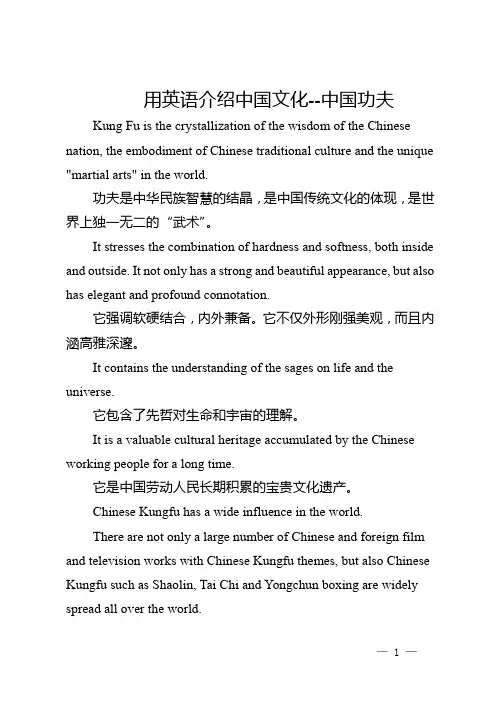
用英语介绍中国文化--中国功夫Kung Fu is the crystallization of the wisdom of the Chinese nation, the embodiment of Chinese traditional culture and the unique "martial arts" in the world.功夫是中华民族智慧的结晶,是中国传统文化的体现,是世界上独一无二的“武术”。
It stresses the combination of hardness and softness, both inside and outside. It not only has a strong and beautiful appearance, but also has elegant and profound connotation.它强调软硬结合,内外兼备。
它不仅外形刚强美观,而且内涵高雅深邃。
It contains the understanding of the sages on life and the universe.它包含了先哲对生命和宇宙的理解。
It is a valuable cultural heritage accumulated by the Chinese working people for a long time.它是中国劳动人民长期积累的宝贵文化遗产。
Chinese Kungfu has a wide influence in the world.There are not only a large number of Chinese and foreign film and television works with Chinese Kungfu themes, but also Chinese Kungfu such as Shaolin, Tai Chi and Yongchun boxing are widely spread all over the world.中国功夫在世界上影响广泛,不仅出现了大量中国功夫题材的中外影视作品,更有少林、太极、咏春拳等中国功夫在全球广泛传扬。
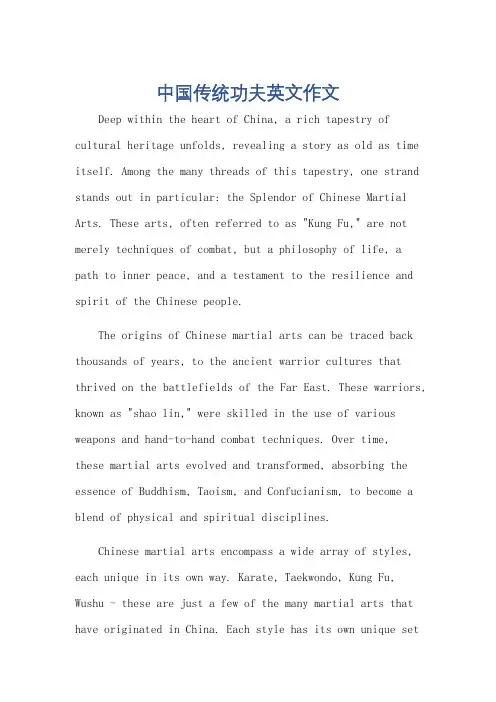
中国传统功夫英文作文Deep within the heart of China, a rich tapestry of cultural heritage unfolds, revealing a story as old as time itself. Among the many threads of this tapestry, one strand stands out in particular: the Splendor of Chinese Martial Arts. These arts, often referred to as "Kung Fu," are not merely techniques of combat, but a philosophy of life, a path to inner peace, and a testament to the resilience and spirit of the Chinese people.The origins of Chinese martial arts can be traced back thousands of years, to the ancient warrior cultures that thrived on the battlefields of the Far East. These warriors, known as "shao lin," were skilled in the use of various weapons and hand-to-hand combat techniques. Over time,these martial arts evolved and transformed, absorbing the essence of Buddhism, Taoism, and Confucianism, to become a blend of physical and spiritual disciplines.Chinese martial arts encompass a wide array of styles, each unique in its own way. Karate, Taekwondo, Kung Fu, Wushu - these are just a few of the many martial arts that have originated in China. Each style has its own unique setof moves, techniques, and strategies, reflecting the diverse regions and cultures of China.The physical aspect of Chinese martial arts is impressive indeed. The practitioners, known as "martial artists" or "kung fu masters," undergo rigorous training, honing their bodies and minds to peak performance. They practice balance, flexibility, strength, and endurance, all while maintaining a state of inner calm and focus. The result is a physical prowess that is both awe-inspiring and breathtaking.But the true essence of Chinese martial arts lies beyond the physical. These arts are a way of life, a philosophy that teaches the practitioner how to live in harmony with oneself and with the universe. They emphasize the importance of discipline, respect, and the pursuit of inner peace. The martial arts are also a powerful tool for self-defense, teaching individuals how to protect themselves and their loved ones in times of need.The impact of Chinese martial arts has been felt not only within China, but also around the globe. These arts have been exported to every corner of the world, attractingmillions of followers and practitioners. They have become a bridge between cultures, a way for people from different backgrounds to connect and understand each other.In conclusion, the Splendor of Chinese Martial Arts is a testament to the rich cultural heritage of China. These arts are not just about combat or physical prowess; they are about the pursuit of inner peace, the cultivation of discipline and respect, and the celebration of human spirit and resilience. As we look towards the future, it is important to remember that the Splendor of Chinese Martial Arts is not just a part of China's past; it is also a vital part of its present and future.**中国传统功夫的辉煌**在中国的心脏地带,一块富含文化遗产的织锦展开,揭示了一个与时间同样古老的故事。

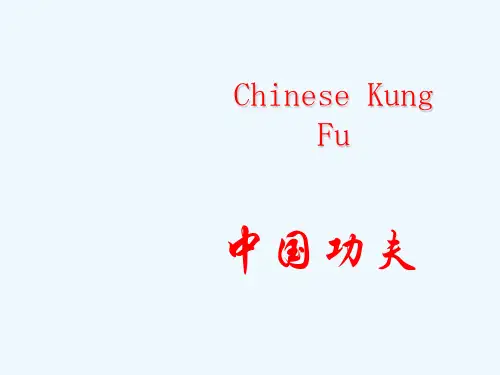
中国功夫英语PPT演讲稿第一篇:中国功夫英语PPT演讲稿Traditional martial arts are part of china's outstanding culture and it contains the spirit of the chinesenation-specific values, way of thinking, imagination, which embodies the Chinese nation's vitality andcreativity, and intelligence are the crystallization of the Chinese people, but also a treasure for allmankind civilization.The origin of Chinese Martial arts 中国武术的起源Wushu in China goes back to ancient times, originating from productive laboring of the ancient ancestry.In the primitive society, people had to survive by gathering in groups.They lived on hunting with rocks and sticks.Hitting with their hands, kicking with their feet and cutting, chopping or stabbing with simple weapons, they performed all kinds of movements, which displayed certain skills of defense or attacking.These performances made up the substantial background of Wushu.In the clan [klæn] society, there often occurred battles be tween the tribes.Armed forces became the means of plundering.Bows, arrows, casting stones and other rocky items appeared as weapons, being improved gradually according to the needs of fight.When having a rest, especially when celebrating their triumphs, people danced to the imitations of defending and attacking movements, stabbing, blowing and kicking.After prolonged accumulation, the experiences began to be raised to the level of consciousness, hence Wushu came into being.Type of gongfu中国武术的分类Chinese martial arts consist of a number of fighting styles that were developed over the centuries.Those fighting styles can be classified according to common themes that are identified as“families”(家), “sects”(派)or “schools”(门).Styles of Chinese martial arts also can be categorized as the Northern style and the Southern style according to the geographical regions divided by the Huanghe River.Chinese love for martial arts中国人的武侠情缘Chinese love for martial arts can be reflected in many martial arts novels and all kinds of film and television works.The works of Jin Yong, Gu Long, Liang Yusheng is representative of martial arts novels.Recent years, a lot of martial arts writers appear on the mainland.For example, Feng Ge, the writer ofKun Lun(昆仑)and Cang yue, the writer ofTingXueLou Series, who are the representativeof New martial arts writers.It is said that “Outstanding martial arts novelist to write the world faces;and astute readers read out the vicissitudes of life and attitudes of human.” We may not be the astute read ers, but we can at least enjoy martial in our own way.Superb and legendary martial arts, peculiar experience of a survivor, a love story full of pathos attract many readers.Martial arts film and television works are emerging.中国武术精神 The spirit of the Chinese martial arts1个人的武德修养Individual cultivation of martial arts ethics.The practicers should respect teachers, filial piety, and righteousness and should not belligerent.Collective morality.集体的道德观念。
中国传统文化2分钟英语演讲稿范文五篇中国传统文化2分钟英语演讲稿范文五篇中国传统文化源远流长、博大精深,如果用英语演讲稿来介绍中国文化,你会怎么说呢?以下是WTT小编为大家准备的中国传统文化2分钟英语演讲稿范文五篇,欢迎大家前来参阅。
中国传统文化2分钟英语演讲【1】众所周知,功夫熊猫2所示最近,很快成为中国的热门话题。
令人惊讶的是,这家美国电影显示了明亮的中国影像例如功夫和熊猫。
这是文化的全球化的一个很好的例子。
但有两个完全不同的对待它的态度。
有些人认为它表明了中国文化的的影响越来越大。
然而,其他人倾向于采取了相反的观点,并把它作为本土文化资源的入侵。
至于我,我倾向于采取开放的态度,对文化的全球化。
我们可以促进我们自己的文化,同时学习其他文化形式,这是对所有国家有利。
最后,重要的是要注意,每一种文化都有其自身的特点。
随着文化的全球化趋势不断发展,我们应该为我们国家的传统文化的发展和蔓延负责。
我的看法:在学好本土文化的前提下去学习其他国家的文化对民族文化的发展是十分有益的,学习他人的文化固然可取,但要尊重他人的名族文化形式,尽可能的保留其特点,我们要在中国文化全球化的基础上保护好中国文化最本质的东西,我们要对中国的民族文化的传承与发展负责。
my view of culture globalizationas is known to all, kung fu panda 2 was shownrecently and soon became a hot topic in china.surprisingly, this american film shows bright chinese images such as kungfu and panda.this is a good e_le of culture globalization.but there are two entirely different attitudestowards it.some people think it demonstrates the increasing influence of chinese culture.others, however, incline to take the opposite pointof view and regard it as an invasion of native culture resources.as for me, i tend to take an open attitude towards culture globalization.we can promote our own culture and meanwhile learn form other cultures, which is beneficial to all countries.finally, it is important to note that each culturehas its own characteristics.with the evolving trend of culture globalization, we should be responsible for the development and spread ofour national culture tradition.中国传统文化2分钟英语演讲【2】The practice of drinking and serving tea has beenpart of China#39;s cultural identity for centuries.China used to be the world#39;s sole provider of tea.Today, tea is the world#39;s most widely consumed beverage after water, and famous Chinese teas are still highly prized.Tea e_perts estimate that top-quality Longjing will sell for 40,000 to 50,000 yuan per 500 grams this year, about 25 percent higher than last year.The price of mon Longjing will be around 4,000 yuan per 500 grams this year.Though quality tea is highly pursued at home, it seems that it has not secured a strong position in the global market.Li Shiwei is the board chairman of Tianfu Group, a flagship tea enterprise based in Fujian Province, a major production region of oolong tea in China.He says a major problem for today#39;s private tea enterprises is that they do not have enough money to operate on a large scale, let alone undertake promotions overseas.“Most of China#39;s tea enterprises are non-state-owned with lack of funding being their weakest point.We are glad to see that Minsheng Bank is now offering a special loan program for tea enterprises.We hope more banks in China will give us more support in terms of financing.”Li Jia_un, board chairman of Zhejiang Tea Group, China#39;s largest e_porter of green tea, says a lack of widely recognized brand names is holding Chinese teae_ports back and squeezing the industry#39;s profit margin.Li cites his own pany as an e_le.The group mainly sells tea as a raw material rather than a branded product.As a result, its profit margin is only about 5 percent, and sometimes even lower.The tea e_pert adds that Chinese panies should also adapt to the needs of western customers, who might prefer black tea to green, and teabags to loose-leaf teas.Wen Zhongliang, deputy director of the Foreign Trade Department under the Ministry of merce, says it is an urgent task for Chinese tea producers and sellers tobuild up the image of Chinese tea abroad to boost teae_ports.“In addition to ensuring the high quality of Chinese tea, tea enterprises in the country should promote the image of Chinese tea together.It could be something of an effort to e_plain the cultural significance and health benefits of tea to foreigners, but once they realize that, they will find it fascinating.”The trade official suggests that e_isting works such as the Confucius Institutes be used to spread China#39;s tea culture around the world.For CRI, this is Su Yi.中国传统文化2分钟英语演讲【3】my view of culture globalizationas is known to all, kung fu panda 2 was shownrecently and soon became a hot topic in china.surprisingly, this american film shows bright chinese images such as kungfu and panda.this is a good e_le of culture globalization.but there are two entirely different attitudes towards it.some people think it demonstrates the increasing influence of chinese culture.others, however, incline to take the opposite pointof view and regard it as an invasion of native culture resources.as for me, i tend to take an open attitude towards culture globalization.we can promote our own culture and meanwhile learn form other cultures, which is beneficial to all countries.finally, it is important to note that each culturehas its own characteristics.with the evolving trend of culture globalization, we should be responsible for the development and spread ofour national culture tradition.众所周知,功夫熊猫2所示最近,很快成为中国的热门话题。
中国传统功夫英文作文The Splendor of Traditional Chinese Martial ArtsDeep within the heart of China, a rich tapestry of martial arts thrives, a testament to the ancient wisdom and physical prowess of its people. These martial arts, known as Wushu, are not just fighting techniques; they are a philosophy of life, a blend of strategy, discipline, and respect. Each movement, whether it's the fluid grace of Tai Chi or the explosive power of Kung Fu, tells a story of balance, harmony, and inner strength.The practices of Wushu are as diverse as they are ancient, reflecting the diverse regions and cultures of China. They are performed not only in the dojo but also in grand performances, where practitioners demonstrate their skills to the rhythm of drums and cymbals, their bodies moving in perfect synchronicity.These martial arts are not just for combat; they are a way of life. They teach self-defense, but more importantly, they teach self-control, patience, and focus. They are a bridge between the past and the present, connecting China's rich heritage with the modern world.In the global arena, Chinese martial arts have gained recognition and respect, becoming a popular form of exercise and self-development. They are a powerful reminder of China's rich cultural heritage and a testament to the resilience and adaptability of its people.。